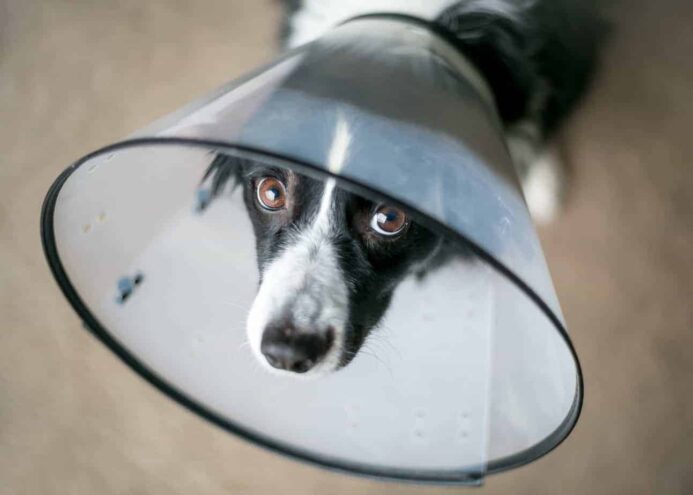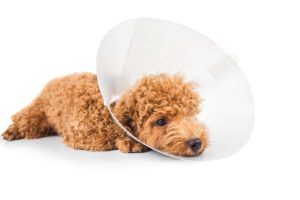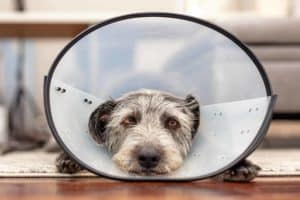
Observing your dog licking wounds can evoke mixed reactions; some find it unpleasant, while others allow it.
Many people believe a dog’s saliva has strong antibacterial properties that can help wounds heal faster. This is a common myth among people who allow dogs to lick wounds.
However, it’s essential to know that this supposed miracle cure is only present in minimal amounts and does not speed up healing.
Excessive licking can hinder the healing process and cause infection.
Therefore, it’s essential to prevent your dog from incessantly licking his wounds. Excessive licking can cause more damage to the injured area.
But using an e-collar, otherwise known as a cone of shame, poses risks.
Why do dogs lick wounds?
Dogs instinctively lick their wounds, but this may not always be best for their healing process.
Self-cleaning instinct
One of the main reasons dogs lick their wounds is that it’s part of their self-cleaning instinct.
Dogs naturally tend to groom themselves by licking different body parts, including any wounds they may have.
This behavior helps keep the wound clean from dirt and debris that may cause infection.
Pain relief
Licking releases endorphins, which act as natural painkillers. So when your dog licks its wound, it may be trying to soothe itself from discomfort or pain.
This behavior resembles how humans rub or massage an injury site for relief.
Stimulate healing process
Dog saliva contains enzymes that can stimulate the production of new skin cells and aid in healing wounds.
Licking also increases blood flow to the wounded area, providing essential nutrients and oxygen for healing.
Habit
Some dogs develop a habit of licking specific areas on their bodies excessively due to boredom or anxiety, even if there is no underlying wound.
This behavior can often become compulsive and difficult to break.
While licking can be beneficial for cleaning and promoting healing, excessive licking can do more harm than good.
Wound licking dangers
One of the main dangers of wound licking is the risk of infection. Dog saliva contains bacteria that can lead to infections and further complications when introduced into an open wound.
That risk is heightened for deep wounds or surgical incisions requiring proper healing without interference.
The constant moisture from saliva can also delay the formation of scabs, which act as a protective layer for the wound.
Excessive licking can irritate the skin around the wound, leading to inflammation and discomfort for your dog. This could cause them to lick even more in an attempt to soothe themselves, creating a vicious cycle that could worsen their condition.
Additionally, dogs with allergies or sensitive skin may develop allergic reactions due to the saliva on their wounds.
Another danger of wound licking is self-inflicted trauma. Some dogs may become fixated on a particular area or object and repeatedly lick it until they create a raw spot or remove the skin.
Boredom or anxiety can trigger this behavior and cause severe damage to the skin that requires medical attention.
Excessive wound licking can also have psychological consequences for your furry friend. It may lead to obsessive-compulsive behaviors where they constantly lick themselves even when there are no injuries present.
This behavior causes distress and could interfere with their daily activities, such as eating or sleeping.
While some wound licking is normal for dogs, monitoring and limiting this behavior is crucial to prevent potential dangers.
As a responsible pet parent, you must take the necessary measures to ensure your dog’s wounds heal without complications.

Elizabethan collar dangers
The Elizabethan collar, or the “cone of shame,” is commonly used to prevent dogs from licking or chewing on wounds.
While it may seem practical, pet owners should be aware of some dangers associated with its use.
First and foremost, the e-collar can cause discomfort for dogs.
The rigid plastic or cardboard material can rub against their neck, creating irritation or even sores.
This discomfort can lead to excessive scratching or rubbing against furniture, which defeats the purpose of using the collar in the first place.
Moreover, wearing an Elizabethan collar can be distressing for dogs.
They may feel restricted and unable to move freely, causing anxiety and stress, which can cause decreased appetite and lethargy.
Another danger to consider is potential injuries caused by bumping into objects while wearing the cone.
Dogs are unaccustomed to having large objects around their necks, making navigating spaces more challenging.
They may accidentally bump into walls, door frames, or furniture while trying to move around with the collar on. These collisions can cause bruises, cuts, or even concussions.
Furthermore, prolonged use of an Elizabethan collar can lead to physical complications such as muscle atrophy in the neck area due to lack of movement.
This shrinkage of muscles can result in weakness and pain when trying to lower their head or neck after being without the cone for an extended period.
Elizabethan collars or inflatable collars also pose physical and psychological dangers. Collars can make dogs feel isolated from their surroundings and restrict their social interactions with humans and other pets.
This sense of isolation can negatively impact a dog’s mental well-being.
Fortunately, seven cone alternatives are equally effective in preventing dogs from licking their wounds.
1. Tell your dog ‘off’
No dog will be happy to nurse an injury. It hurts and makes dogs uncomfortable and unhappy. So, the best step they usually take is to lick the wounds.
Licking wounds also helps block the pain receptors. So, if your dog just had surgery, this could be why he licks.
Nevertheless, you have to prevent him from doing so. Now, how can you achieve this?
Tell your dog ‘off.’
If you can’t be there to monitor your dog, get someone to watch over your dog. Ask the person to monitor your dog and tell your dog off whenever he starts licking his wound.
Should you yell or hit the dog to stop him from licking? The answer is, No! Just use “No” or “Stop that” whenever the dog gets in the act. He will understand and start cooperating sooner than you think.
2. Use barriers for wounds on extremities
When your dog sustains an injury on his paw pad, don’t just cover it up with a barrier. Your first line of action should be to get it treated. In other words, take the dog to a veterinarian to examine and treat the wound.
After that, you can proceed with your plans to use a barrier.
What’s the barrier in this case? It is something that could prevent the dog’s tongue from touching the wound without causing any harm or worsening the pain.
If your dog has an injury on his right or left pad, you can cover it with a sock and fasten it to his leg with surgical tape.
However, remember that your dog will try to remove the sock, particularly if the injury still hurts and he wants to lick it to soothe it.
But then, nothing on earth should make you give in to his demand. Let the sock be there; with time, the dog will get used to it.
3. Use a bandage
A bandage is another barrier you can place over your dog’s wound to prevent it from licking, and avoid using an Elizabethan collar.
You can also use bandages on extremities such as tails and legs or place them on the dog’s body or wherever he is injured.
Do not place a bandage over an injury that hasn’t been treated.
If you are unsure what to apply to your dog’s injury, visit your vet doctor for professional help.
After the treatment, you may add bandages to the injured area to ensure the dog’s tongue doesn’t get to the injury.
It would help if you remembered to use a fresh bandage on the injured area after bathing the dog.
4. Apply bitter substances
Your dog may continue licking his wound even after placing a bandage.
Here’s a simple step for you. Get a bitter substance and apply it on top of the bandage. You can apply it directly to the incision or wound on the dog’s body.
What bitter substance can one use? An example is bitter apple. You may also decide to place anti-lick strips over the dog’s injury.
Is the bitter apple spray safe? The answer is yes. Dog owners can use it to prevent dogs from licking their injuries or bandaged wounds and from chewing on them. The bitter apple spray contains ingredients that are harmless to dogs.
You can make a homemade spray to stop your dog from licking its wound by mixing two cups of apple cider vinegar with one cup of white vinegar. Alternatively, you can mix two cups of lemon juice with one cup of white vinegar.
Use small amounts of these home remedies to determine how much will keep your dog from licking its wound.

5. Try essential oils or herbal sprays
Essential oils or herbal sprays are a natural and effective way to prevent your dog from licking wounds without using a collar. These can be easily found in pet stores or even made at home.
Essential oils are highly concentrated plant extracts used for centuries for their medicinal properties.
They can help soothe skin irritations, reduce inflammation, and repel insects — all beneficial for healing and preventing your dog from licking their wounds.
Lavender and chamomile are essential oils that are safe for dogs and have wound-healing properties. Dilute essential oils with a carrier oil such as coconut or olive oil before applying them to your dog’s skin.
To use essential oils as a deterrent for licking wounds, mix a few drops of the chosen oil with water in a spray bottle and lightly mist them onto the affected area.
Alternatively, add diluted essential oils to a bandage before wrapping it around the wound.
Herbal sprays contain natural ingredients such as calendula, comfrey, witch hazel, and aloe vera — all of which have anti-inflammatory and soothing properties.
You can purchase pre-made herbal sprays specifically designed for pets or make your own at home by infusing dried herbs in hot water until it cools.
Then, strain the mixture into a spray bottle and lightly spritz it onto your dog’s wound multiple times daily.
Although essential oils and herbal sprays are generally considered safe for topical use on dogs’ skin, don’t let your pet eat them. Keep the bottles out of reach, and clean your dog’s wound with a mild soap and water solution before applying any products.
Essential oils and herbal sprays promote faster healing, reduce discomfort, and prevent infections.
6. Use medication
Some dogs have made licking wounds a habit and are so obsessed they can spend the whole day licking while awake.
They will still lick the wound even when you place a bandage or other barriers on the injured spot.
If your dog behaves in this manner, then he surely needs help.
So, take him to your vet for treatment. Often, your vet will prescribe an anti-psychotic medication or suggest other remedies.
Your vet should know what’s best.
7. Let your dog wear a onesie
Consider dressing your dog in a onesie or recovery suit to help cover up the wound and prevent the dog from licking it.
But make sure your dog’s onesie isn’t too tight. It must be flat to your dog’s fur to make it feel comfortable while preventing it from licking the wounded area.
You can get a baby onesie for a small dog and a big onesie for a large dog.
However, if you are confused about a suitable onesie, visit any pet supply shop. Be sure to take your dog’s correct measurements to ensure a proper fit.
Can I make a onesie for my dog? The answer is yes. You can create one at home from used clothes. Cut any cloth you feel would fit your dog correctly and put it on the dog.
Also, if you have a big dog, it can wear your t-shirt and tie it at the dog’s waist region to prevent it from coming off.
Potential costs
The potential costs associated with each alternative method can vary.
For example, you may have ongoing expenses if you opt for bitter-tasting sprays or topical ointments to deter licking.
Alternatively, a soft, protective doggie garment may involve the initial purchase cost.
If you seek professional help or behavior modification training to address excessive licking behaviors, there may be costs associated with consultations or sessions with a qualified trainer or behaviorist.
It’s vital to consider the potential financial implications of each alternative method and choose the one that best suits your dog’s needs and your budget.
Watch for signs of stress
Signs of distress or discomfort when using e-collar alternatives include your dog excessively pawing or scratching at the wound site, restlessness, irritability, or attempts to remove the alternative device.
Additionally, watch for signs of skin irritation, redness, or discomfort in the area where the alternative device is placed.
In that case, it’s important to reassess the fit and comfort.
Any changes in your dog’s behavior, such as decreased appetite, increased anxiety, or lethargy, could indicate that the alternative treatment is causing distress.
It’s vital to carefully observe your dog for any warning signs and consult your veterinarian if you have concerns about your dog’s comfort or well-being.
Final thoughts to stop dog-licking wounds
You must correct your dog whenever he displays unacceptable behavior, like licking his wounds.
Don’t bank on the myth that a dog’s saliva can heal his wounds faster.
Instead, talk to your vet and treat any injury your dog sustains.
But before and after the treatment, you must stop dog-licking wounds to allow them to heal.
Roadmap to optimal dog health: Navigate from A to Z with confidence
